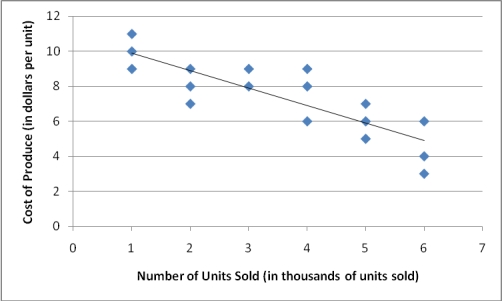A) the correlation coefficient
B) the coefficient of determination
C) estimated Cohen's d
D) the test statistic
F) All of the above
Correct Answer

verified
Correct Answer
verified
Multiple Choice
A researcher measures the correlation between self-esteem (high,low) and physical fitness scores among school athletes.In the study,12 participants reported high self-esteem and 12 reported low self-esteem.If sY = 9.06 and MY1 - MY2 = 11,then what is the value of the correlation coefficient?
A) .61
B) .30
C) .39
D) there is not enough information to answer this question
F) A) and C)
Correct Answer

verified
Correct Answer
verified
Multiple Choice
The correlation coefficient measures the extent to which changes in one factor are ______ in a second factor.
A) related to changes
B) causing changes
C) causing variability
D) all of these
F) C) and D)
Correct Answer

verified
Correct Answer
verified
Multiple Choice
A researcher measures the following correlation between cost of produce and number of units sold.Which description best explains the relationship between these two factors?

A) As the cost of produce increases, so does the number of units sold.
B) Less expensive produce is associated with an increased number of units sold.
C) Less expensive produce is associated with a decreased number of units sold.
D) No linear pattern is evident.
F) All of the above
Correct Answer

verified
Correct Answer
verified
Multiple Choice
If r = .65 and n = 36,then what is the value of 2?
A) 3.84
B) 5.99
C) 15.21
D) 23.40
F) B) and D)
Correct Answer

verified
Correct Answer
verified
Multiple Choice
Which of the following would not be reported for a correlation?
A) the sample size
B) the coefficient of determination
C) the critical values for each test
D) the strength and direction of the correlation
F) B) and D)
Correct Answer

verified
Correct Answer
verified
Multiple Choice
The appropriate correlation coefficient for measuring the direction and strength of the linear relationship between two ranked or ordinal variables is ______.
A) the Spearman correlation coefficient
B) the point-biserial correlation coefficient
C) the phi correlation coefficient
D) none of these
F) B) and C)
Correct Answer

verified
Correct Answer
verified
True/False
The denominator of the Pearson correlation coefficient measures the extent to which two factors vary together.
B) False
Correct Answer

verified
Correct Answer
verified
True/False
The formula for the phi correlation coefficient was derived from the formula for the Pearson correlation coefficient.
B) False
Correct Answer

verified
Correct Answer
verified
True/False
The sign (+ or -)of a correlation coefficient indicates the direction of a relationship between two factors.
B) False
Correct Answer

verified
Correct Answer
verified
True/False
The point-biserial correlation coefficient is used to measure the correlation between two dichotomous variables.
B) False
Correct Answer

verified
Correct Answer
verified
Multiple Choice
A researcher measures the following correlation: r = -.21.What is the value of the coefficient of determination?
A) .04
B) -.04
C) .42
D) -.42
F) A) and D)
Correct Answer

verified
Correct Answer
verified
True/False
Three assumptions for a correlation are homoscedasticity,linearity,and normality.
B) False
Correct Answer

verified
Correct Answer
verified
Multiple Choice
We convert r to a chi-square statistic for which of the following correlation tests?
A) Pearson
B) Spearman
C) point-biserial
D) phi
F) C) and D)
Correct Answer

verified
Correct Answer
verified
True/False
The correlation coefficient varies between 0 and 1 and can never be negative.
B) False
Correct Answer

verified
Correct Answer
verified
Multiple Choice
The assumption that there is an equal variance or scatter of data points dispersed along the regression line is referred to as ______.
A) normality
B) linearity
C) homoscedasticity
D) restriction of range
F) All of the above
Correct Answer

verified
Correct Answer
verified
Multiple Choice
A correlation coefficient can ______ demonstrate cause.
A) always
B) never
C) mostly
D) intermittently
F) A) and C)
Correct Answer

verified
Correct Answer
verified
True/False
If r = 0.026 and df = 10,then t = 7.20.
B) False
Correct Answer

verified
Correct Answer
verified
Multiple Choice
A statistical procedure used to describe the strength and direction of the linear relationship between two factors is called ______.
A) effect size
B) power
C) a correlation
D) coincidence
F) B) and D)
Correct Answer

verified
Correct Answer
verified
True/False
The correlation coefficient can be converted to a chi-square statistic.
B) False
Correct Answer

verified
Correct Answer
verified
Showing 41 - 60 of 80
Related Exams